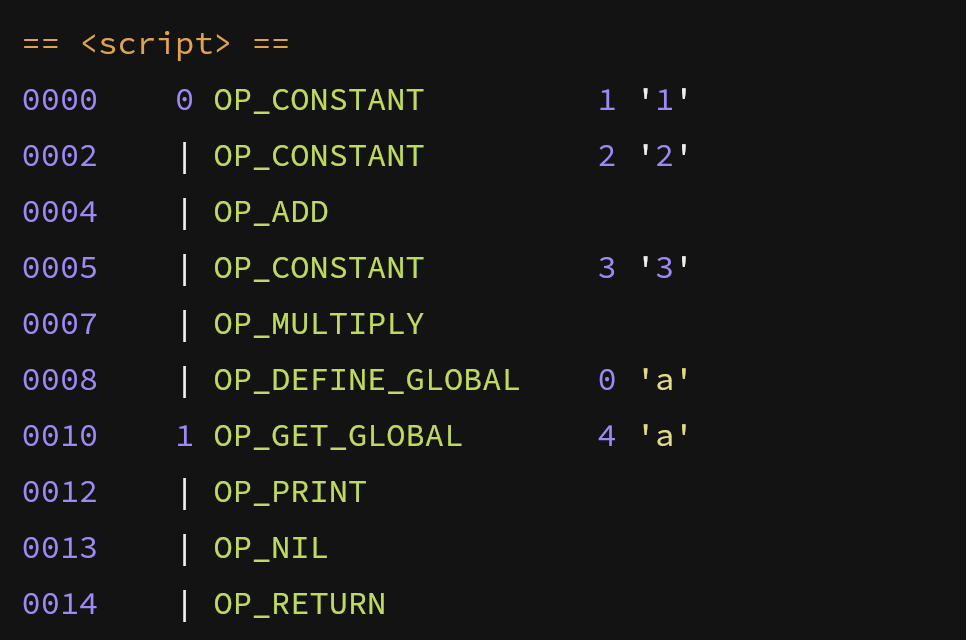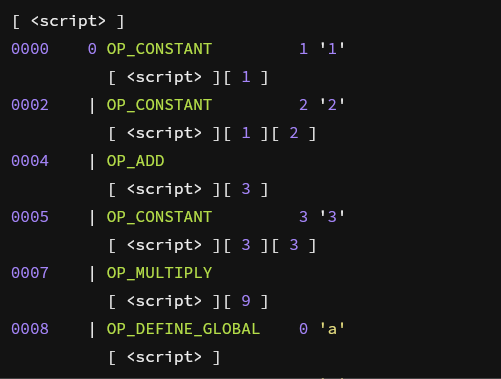dlox
A full-featured VM written in dart
Live editor
Head over to the live editor to play with dlox online! The editor is based on the code_text_field flutter widget, and has been compiled in javascript to run entirely in the browser. Indeed, both dlox and the editor
Implementation
dlox is a strict superset of the fantastic lox language designed by Bob Nystrom.
Features
Common with lox VM
- Arithmetic operations
- Control flow
- Loops (for & while)
- Stack based local variables manipulation
- Scoping & closures
- Classes & inheritance
Extensions
- Suport for list and maps
var list = [1, 2, 3];
var map = {"a": 1, "b": 2};- Container indexing
print [1, 2, 3, 4][1:-1]; // [2,3]
print "a cool feature"[2:]; // "cool feature"- Container traversal
for v in "test" {
print v; // t, e, s, t
}
for v in [1, 2, 3] {
print v; // 1, 2, 3
}
// All containers also support index extraction
for v, k in {"a": 1, "b": 2} {
print k + " " + v; // 0 a, 1 b
}- Usual mathematical functions
var theta = 3.14 / 4;
var a = sin(theta);
var b = sqrt(1 - cos(theta)^2);
var c = ceil(abs(round(-theta)));- Controlled execution
Pause on each line, and limit the number of instructions per run for asyncronous execution
Using the CLI
A repl can be spun up this way
# in dlox
dart lib/main.dart
> fun sum(a, b) { return a + b; }
> print sum(2, 3) # 5Or a file can be executed
# in dlox
dart lib/main.dart editor/assets/snippets/fibonacci.loxVM primer
The VM utilizes a stack to maintain all its local variables, function arguments, temporary operation results and return values. As its name suggets, a stack is a simple data structure supporting two main operations
- Pushing and element on top of it
- Popping its topmost element
Let's see how that works Head over to the editor and enter the simple program
var a = (1 + 2) * 3;
print a;The top right panel shows the compiled bytecode
On small screens, the compiler panel is hidden by default. Press the rightmost button on the top toolbar to show it
Here's a breakdown of the compile program
OP_CONSTANT '1' // Push 1 on top of the stack
OP_CONSTANT '2' // Push 2 on top of the stack
OP_ADD // Pop the two last elements off the stack
// Add them and push the result on the stack
OP_CONSTANT '3' // Push 3 on top of the stack
OP_MULTIPLY // Pop the two last elements off the stack
// Multiply them and push the result on the stack
OP_DEFINE_GLOBAL 'a' // Pop the last stack entry
// Assign it to the global variable 'a'
OP_GET_GLOBAL 'a' // Push the global variable 'a' on the stack
OP_PRINT // Pop the last stack entry
// Print it
OP_NIL // Push NIL on the stack
OP_RETURN // Pop and return the last stack valueWow, that seems a lot for such a simple program! Well, breaking it down in simple instructions allows the Virtual machine to execute it in a really streamlined fashion. All it needs to do is rip through the instructions one by one while carefully bookkeeping the global variables and managing the stack
Now run that nifty piece of code. The terminal output should print 9. The bottom right panel shows the VM trace
On small screens, the VM panel is hidden by default. Press the rightmost button on the bottom toolbar to show it
Here's the first few lines
The VM trace shows instruction per instruction what the state of the stack is. We can see that is starts with the <script> object, and then proceeds to add 1 + 2, and to mutiply the result by 3, before popping it and assigning it to the global variable 'a'.
For further in-depth exploration, make sure to play with the examples in the top left drawer and make your own! Of course, Bob's book explains everything in incredible details.
Benchmark
To really unleash the VM thirst for code, disable the trace by swiching the performance button on the bottom toolbar.
That should make the execution significantly faster. The indicator on the left shows the average number of instructions per second
Running the test suite
Should you feel like tweaking things to you liking, a little regression testing here and there never hurts
# in dlox
dart lib/test.dart





